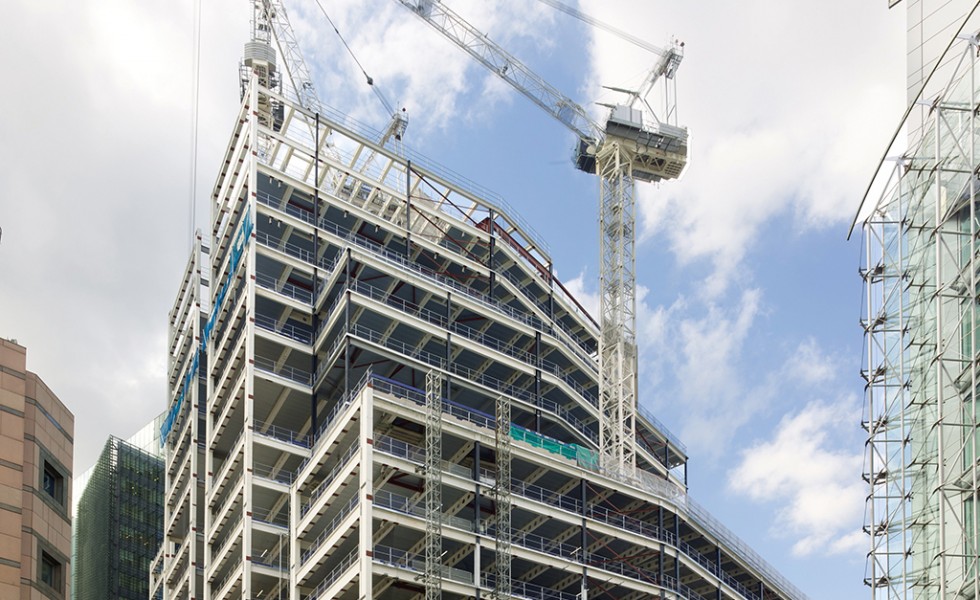Set in stone: 20-22 Ropemaker Street
7/6/23
In a sea of concrete and glass, Skanska is working on London's tallest limestone-faced building since St Paul's Cathedral
Severe Acute Respiratory Syndrome Coronavirus 2 has much to answer for. Away from the horrific death toll it has inflicted upon the global population and the withering side effects of long Covid, the virus has created financial turmoil across the world and changed the working lives of millions.
When the government told all but essential workers to stay at home, in one fell swoop city centres across the country fell silent, with office blocks standing empty and unused. Even now, as the third anniversary of the first lockdown announcement approaches, our city centres are still not quite the busy, buzzing hives of activity they were back in 2019.
Yet despite the onset and acceptance of hybrid working, demand for top-quality office space remains high, nowhere more so than at the beating heart of the UK's financial sector, the City of London. Here, commercial property development continues unabashed as firms battle to sate a hunger for Grade A office space that shows no signs of abating, according to Stuart Bodman, head of development at office investment and development firm Old Park Lane Management (OPLM). "The demand for high-quality office space remains strong, particularly if it can prove its sustainability credentials," he says.
Which is exactly where its latest office development near the entrance to Moorgate tube station comes in. Main contractor Skanska is closing in on the delivery of the 25-storey-tall 20-22 Ropemaker Street project. This structure, clad in Portuguese limestone, is set to become London's tallest limestone-faced building since St Paul's Cathedral was completed in 1710. It will provide more than 40,000 square metres of office space plus additional ground floor retail space, built to exacting sustainability and occupier wellbeing standards. The completed development is targeted to be BREEAM 'Outstanding' and 'Platinum' under version two of the WELL Building Standard – the mechanism for measuring a development's performance against its potential impact on human health and wellbeing.
The Ropemaker scheme was first mooted in 2015, with the project becoming the largest commercial development ever given the all-clear by planning authority Islington Council. With work commencing on site in March 2019, the team brought in demolition contractor Keltbray to clear the existing six- and seven-storey 1960s-built reinforced concrete buildings that occupied the footprint, before work on the scheme started in earnest in February 2020.
The building itself is based on a three-storey-deep basement featuring 900mm-diameter, secant pile retaining walls to 30m. Some on the northern elevation measure 1200mm in diameter. "There is a party wall on the northern elevation and the increased diameter was to protect that adjacent building while affording the opportunity to reduce the amount of temporary propping in that area," says Hughes, adding: "It was a 16m-deep bulk dig through a 2m layer of made ground and into underlying London clay. Groundwater was never really an issue but some very heavy temporary works and shoring was required."
The basement was excavated through a ramp built from the dig to street level with 120 wagon loads of arisings being moved per day. A huge advantage for the project team was that much of this work occurred during the lockdowns, with quiet roads across the city making it easier to bring the traffic to and from site.
Load-bearing rotary bored piles – 24 in total at 900mm and 1200mm diameters – have been installed to 30m beneath the project's four stair and lift cores. Those cores measure 25, 22 and 19 storeys with the shortest just nine storeys, reflecting the stepped nature of the building and the roof terraces and outside space provided across many of the structure's upper floors (see box, below).
Anyone who has lived and worked in any of the UK's major cities will understand what a blessing even the tiniest patch of outdoor space can be. The COVID-19 lockdowns taught us that much. Whether it's a large roof terrace or the merest scrap of garden, the slightest offering of fresh air and a glimpse of nature can be a godsend.
The Ropemaker development stands proud as a scheme that is delivering that access to biodiversity and nature for its tenants. The building's stepped design offers outside space across almost three-quarters of its office floorplates through balconies or its five large landscaped roof terraces. And while this reduces the potential amount of lettable floorspace, it affords its occupiers enviable access to central London's fresh air, a key component in its bid to meet wellbeing standard WELL V2 'Platinum'.
Achieving BREEAM 'Outstanding' 2018 is also a must. The team is using recycled and secondary aggregates to reduce waste to landfill and a sustainable procurement plan to ensure the FSC certification of timber used on site. A photovoltaic array on the roof and generators powered by diesel alternative hydrotreated vegetable oil (HVO) fuel will help the development meet its lofty targets.
More than 7,500 tonnes of structural steel has been installed by steelwork specialist William Hare to create the building's frame, which features 13.5m spans and 450mm-diameter circular steel columns to provide support across the inner office floorplate. Circular steel sections were chosen over I-section columns to give a more aesthetic finish. Given its offset from the cores, Vierendeel trusses are used to help stiffen the frame with lightweight aggregate being used within the 130mm-thick cast-in-situ floor slabs.
The facade is dominated by Portuguese limestone cladding (see box, below) across the largest elevations while black ceramic-tile clad glazing units feature predominantly on its western elevation. Double-height glazing wraps around the structure at ground floor level and reveals the feature staircase within the office reception.
Deep in the bowels of the building, changing facilities for the workforce reflect the quality-workmanship ethos espoused by OPLM, with facilities more reminiscent of a private members' club than any bog-standard office offering. There are 432 lockers, 21 showers and storage for 240 bicycles. There are no car-parking spaces.
The bulk of the building's mechanical and electrical and plant services sit in the basement and the eleventh floor, although there are smaller units on the roof. The mid-building air-handling unit will offer better quality air at intake compared with any at lower levels and free up space on other floors.
There's still plenty for the Skanska team to be getting on with before the project is handed over later this year. International law firm Linklaters has already agreed to make the development its headquarters and with demand for high-quality, sustainable, environmentally considerate central London office space remaining resilient, it shouldn't take too long for the rest of the Ropemaker floorspace to be snapped up.
The slowly returning post-pandemic commuters exiting Moorgate Station already have a new landmark in the sea of concrete and glass. Clad predominantly in a bright – almost white – 'Creme Royale' limestone, the Ropemaker tower already offers a striking respite to the eye despite still being months away from completion.
Installed using three tower cranes to lift from the project's delivery lanes around the periphery of the site, the 50mm-thick Portuguese limestone panels form cladding units that generally measure 3m x 2m and weigh as much as 4.5 tonnes. The finish has been chosen for its longevity as much as its aesthetic. Client OPLM is keen that the building is as robust and flexible as possible without compromising on the quality of its construction at any point. "The Portuguese limestone offers consistency and durability," explains Ed Thomson, associate director at development manager Co-Re. "It was a conscious decision to go down the full stone-clad route. The building will have a long life and has been designed so that not only is it robust and finished to the highest quality, but it can be easily reconfigured and repurposed at any point in the future."
That flexibility has already been tested. With law firm Linklaters making the building its headquarters, the team has adapted the initial design to provide two separate entrances at ground floor level.
Source; Construction News

